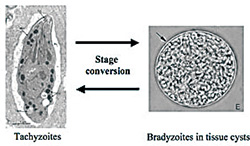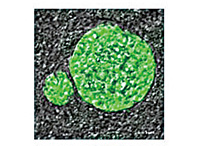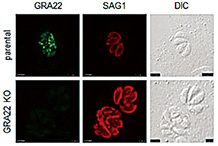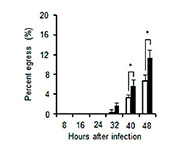Research Unit for Molecular Diagnostics
Professor Naoaki Yokoyama
Bovine piroplasmosis (bovine theileriosis and babesiosis) caused by species of genera Babesia and Theileria, is characterized by fever and anemia. The disease usually results in severe economic losses in cattle industry worldwide. However, preventive and control measures against bovine piroplasmosis have often been ineffective. With an ultimate aim of minimizing the incidence of bovine piroplasmosis, we conduct research to 1) determine the current status of bovine piroplasmosis in Japan and other endemic countries; 2) identify tick vectors transmitting bovine Theileria, and thereby establish systematic tick-control measures; 3) determine immunological responses against Theileria infection in cattle and develop vaccine; 4) clarify the mechanisms by which Babesia invades erythrocytes with the objective of vaccine development; 5) establish effective techniques and tools to analyze the genetic polymorphism in vaccine candidate antigens; and 6) develop made-to-order type subunit vaccines effective in different endemic regions. To expedite our aim of eliminating bovine piroplasmosis, we maintain a strong international collaborative network and accept postgraduate students and young postdoctoral researchers for the development of human resources in countries where bovine piroplasmosis is endemic.
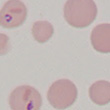
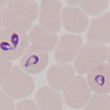
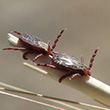
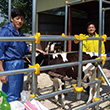


Associate Professor Rika Umemiya-Shirafuji
Ticks are obligatory hematophagous arthropods and are known to be important vectors for various pathogens in vertebrates, such as Babesia and Theileria parasites. Our laboratory focuses on the molecular mechanisms underlying nutrient metabolism in unfed or fed ticks and tick oogenesis. Our aim is to contribute to the development of new methods for controlling ticks and tick-borne pathogens.
Nutrient metabolism in unfed ticks
Most hard tick species have a life span of several months or years. Their life is essentially composed of relatively short parasitic periods and long non-feeding periods, without intake of blood. This remarkable viability is important for understanding the biology and epidemiology of ticks and tick-borne pathogens.
Nutrient metabolism in fed ticks
Energy and nutrient reserves provided by digestion of a blood meal in female ticks allow the synthesis of vitellogenin (Vg), the yolk protein precursor. Synthesis and uptake of Vg are essential processes in the oogenesis of ticks.
Vector biology
Using ticks infected with parasites, we are studying the relationship between transmission of parasites and nutrient metabolism of ticks.
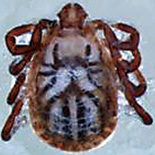
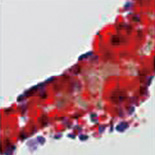
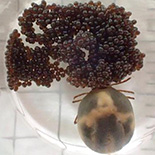
Assistant Professor Okajima Misuzu
Based on the experience in creating genetically engineered mice, I would like to establish model animals for protozoan diseases.
Using established models, I would like to contribute to the elucidatiion of the relationship among protozoa, ticks and host animals.
Research Unit for Advanced Preventive Medicine
Professor Noboru Inoue
Associate Professor Keisuke Suganuma
Trypanosomoses are endemic in many countries and affect both humans and animals. However, no effective control measures are available for this disease. We therefore aim to develop and establish effective control strategies for trypanosomoses.
Studies on developmental-stage conversion mechanisms. (Fig. 1)
Developmental-stage conversion (or cell differentiation) is essential for trypanosomes to parasitize mammalian hosts and vectors. Therefore, we aim to reveal the stage conversion mechanisms using gene manipulation technology, with the aim of developing new control strategies for trypanosomoses.
Global surveillance and establishment of new laboratory strains of trypanosomes. (Fig. 2)
We aim to establish effective control strategies for trypanosomoses in endemic countries based on field surveillance data. In addition, we intend to isolate and establish field strains of trypanosomes for further study.
Development of novel trypanocidal drugs.
We aim to find novel trypanocidal compounds by using in vitro drug screening systems and mouse models.
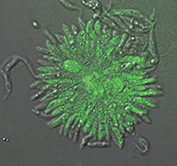
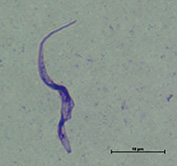
Fig. 1: GFP expressed transgenic Trypanosoma congolense (Suganuma et al., 2012 & 2013)
Fig. 2: Trypanosoma equiperdum isolated from Mongolia (IVM-t1 strain) (Suganuma et al., 2016) (Trypanosoma equiperdum)
Research Unit for Infection and Pathology
Professor Makoto Igarashi
Toxoplasmosis is a zoonotic disease latently infecting 20% to 30% of the world’s population. Toxoplasma causes serious problems in immune-suppressed people such as HIV patients and the elderly as well as in congenitally infected infants. This laboratory is working on unraveling the mechanism of Toxoplasma’s parasitism in hosts.
Main Research Project
- Understanding Toxoplasma’s parasitism in host cells:
We aim to identify target molecules for new medicines by isolating molecules involved in Toxoplasma’s parasitism in host cells. - Understanding the transition process from acute to chronic Toxoplasma infection:
During the transition from an acute to a chronic infection Toxoplasma changes its life cycle from a propagation type to a cyst-forming type. By uncovering the mechanism of this change we aim to utilize it for vaccine development strategies.
